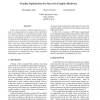Free Online Productivity Tools
i2Speak
i2Symbol
i2OCR
iTex2Img
iWeb2Print
iWeb2Shot
i2Type
iPdf2Split
iPdf2Merge
i2Bopomofo
i2Arabic
i2Style
i2Image
i2PDF
iLatex2Rtf
Sci2ools
107
click to vote
3DPVT
2006
IEEE
2006
IEEE
Scanline Optimization for Stereo on Graphics Hardware
In this work we propose a scanline optimization procedure for computational stereo using a linear smoothness cost model performed by programmable graphics hardware. The main idea for an efficient implementation of this dynamic programming approach is a recursive scheme to calculate the min-convolution in a manner suitable for the parallel stream computation model of graphics processing units. Since many image similarity functions can be efficiently calculated by modern graphics hardware, it is reasonable to address the final disparity extraction by graphics processors as well. Our timing results indicate that the proposed approach is beneficial for larger image resolutions and disparity ranges in particular.
3DPVT 2006 | Applied Computing | Graphics Hardware | Programmable Graphics Hardware | Scanline Optimization Procedure |
Related Content
| Added | 10 Jun 2010 |
| Updated | 10 Jun 2010 |
| Type | Conference |
| Year | 2006 |
| Where | 3DPVT |
| Authors | Christopher Zach, Mario Sormann, Konrad F. Karner |
Comments (0)

